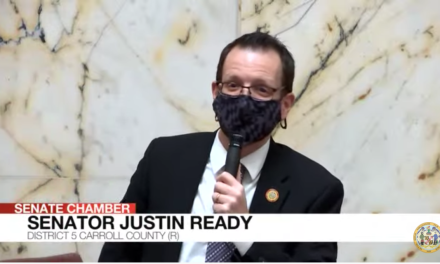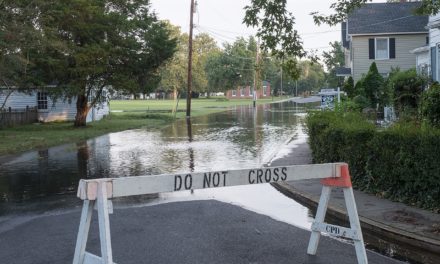By Shruti Kumar and Victoria Ebner
Capital News Service
As COVID-19 cases rise throughout Maryland, Gov. Larry Hogan’s urgent tone has prompted nearly all school districts currently practicing hybrid learning to close their doors to students this fall.
Back in August, state officials left the decision of whether to reopen largely up to individual county education executives. The state only advised that schools should consider limiting in-person instruction or close if their county’s positivity rate exceeded 5 percent and the new case rate was over 15 cases per 100,000.
As a result, each county made its own plans for how to handle reopening and online learning. However, steep case rates have recently forced most schools to go fully virtual.
Most school systems opened for some form of in-person learning
While the beginning of the school year started out virtual for all Maryland public school districts, most counties originally had plans in place to switch to hybrid learning prior to January 2021 and many were able to welcome select groups of students back.
Some school districts made the transition earlier than others. Washington and Worcester counties returned some students to schools as early as September, with other districts, like Kent and Harford, following suit in October and November.
“Overall, the feedback we have received has been that families have appreciated our efforts to bring back all students who wish to return to the classroom,” Louis Taylor, Worcester Superintendent of Schools, wrote in an email.
Some parents, however, have not been satisfied with the approach schools have taken to bring students back. Kristen DeBoy Caminiti, a mother in Anne Arundel County and member of the AACPS Superintendent’s Parent Involvement Advisory Council, believes that schools are reopening hastily and are failing to prioritize children in need.
“I want schools open for the kids who need it, but I refuse to make everybody sacrifice negatively for a plan that is not serving anyone’s needs well,” Caminiti said. “Equity is tailoring our approach to the individual needs of each child and not every child needs the same thing in order to have an equal chance of succeeding.”
For Wicomico County Superintendent Donna Hanlin, parent feedback has been mixed. In the end, it was just about making the best collective decision possible.
“We knew [starting out virtual] wouldn’t make everyone happy, but we believed it served in everyone’s best interests for health and safety reasons, while also providing instructional consistency for both students and teachers,” Hanlin wrote in an email. “As for reactions from parents to students returning via hybrid model, it has been mostly positive, although a lot of parents also made the decision to keep their children at home because of COVID-19 health concerns.”
Of the counties that decided to engage in hybrid instruction, some began phasing students in based on grade level. Wicomico County invited Pre-Kindergarten students back on Oct. 19 and Kindergarten on Oct. 26, planning for other grades to return in the following weeks.
A few school districts had students attend in person on alternate days. Talbot County Public Schools had students in Pre-K through Grade 5 return on Oct. 12 with an ‘AA/BB’ schedule, where students are scheduled to come in person on either Monday and Tuesday or Thursday and Friday. Wednesday was set as an asynchronous day for all students, with the same protocol kicking in for high school students on Oct. 19.
While making these complex decisions, school districts have had to consider students’ home lives and access to an internet connection, nutritious meals and other educational and technical resources.
According to ProPublica, some Baltimore City students were experiencing difficult living situations that made navigating virtual learning environments difficult or impossible. To combat food insecurity, school districts in many Maryland counties are offering free bagged meals for pickup at numerous school sites.
Some schools have already set a return date
High positivity rates of COVID-19 have soared across Maryland in the past several weeks. Statewide, the positivity rate has risen above seven percent in recent days and has continued to climb, according to Maryland’s COVID-19 Data Dashboard on Maryland.gov –– reporting an 8% 7-day average positivity rate as of Dec. 3.
State data updated Dec. 2 shows that schools across Maryland have experienced outbreak-associated cases in schools. Grace Academy in Washington County currently tops the list with 19 total positive cases, with the Glenelg Country School in Howard County and the Bullis School in Montgomery County following behind with 11 and 10 positive cases, respectively.
While almost all Maryland school systems announced in November that they’re going all virtual, some of them made the call sooner. Dorchester County was among the first counties in the state to shut back down at the end of October after Health Officer Roger Harrell announced that test-positivity rates in the county went from 2.9% to 6.1% in an eight-day period.
Some school systems have already set dates for when they anticipate bringing students back into the classroom.
Public school districts like Worcester and Carroll are aiming to reopen for in-person learning in early January. Worcester aims to reopen on Jan. 4 and Carroll County has set Jan. 7 as a tentative date.
“We recognize the importance of our students being able to return to the classroom environment, but the health and safety of our students and staff is always our top priority,” said Taylor, Worcester’s Superintendent.
A few school districts are projecting a later start for in-person learning due to safety concerns. Howard County Board of Education has extended virtual learning for its school districts through mid-April at the earliest.
Lavanya Sithanandam, a mother in Montgomery County and local pediatrician, noted feeling disappointed in the Montgomery County Public School district’s approach to instruction delivery.
“I think Montgomery County Public Schools has failed my patients, especially my minority patients, by not releasing a plan earlier,” Sinthanandam said. “We have documented a 30% increase in mental health referrals in our practice since March. A lot of children are coming in with symptoms of depression, anxiety, even suicide attempts relating to social isolation.”
Jessica Hasson, a mother in Montgomery County and local psychologist, shared similar sentiments. Hasson noted that students are overwhelmed by virtual learning and stated that students with disabilities and younger children should be prioritized for hybrid education.
“[Young children] are not designed to sit in front of a computer… Mentally, emotionally, cognitively — it’s not where they are developmentally,” Hasson said. “We have the equity hubs, we have the educational hubs, right in the school buildings… We can use what [the schools] have done and have done successfully to bring in small groups.”
Maryland has recently surpassed 200,000 COVID-19 cases since the start of the pandemic, and on Dec 2, the state reported the most COVID-19 deaths since June.
On Dec. 1, Hogan held a press conference to comment on the rising numbers and ask for more medical professionals to step up to work at hospitals as capacity rose by 51 percent in two weeks.
Toward the end of last month, Hogan ordered bars to close early, limited capacity at hospitals and nursing homes and banned fans from stadiums –– all changes that went into effect Nov. 20.
“This is not the flu. It’s not fake news. It’s not going to magically disappear just because we’re all tired of it and we want our normal lives back,” Hogan said on Nov. 17, during the time when many schools began to close back down. “We are in a war right now and the virus is winning.”








Recent Comments